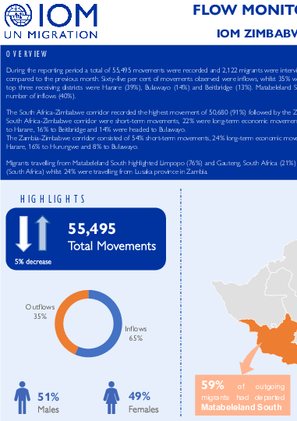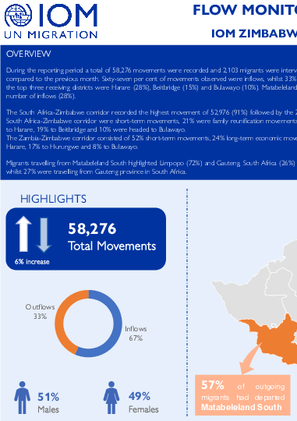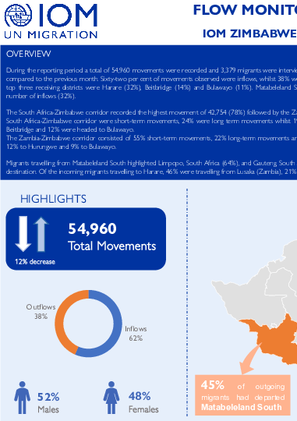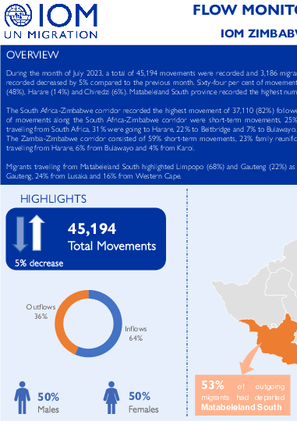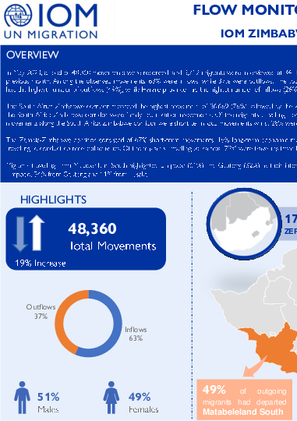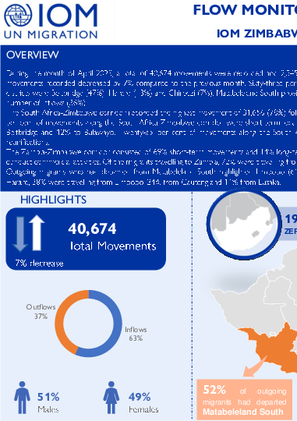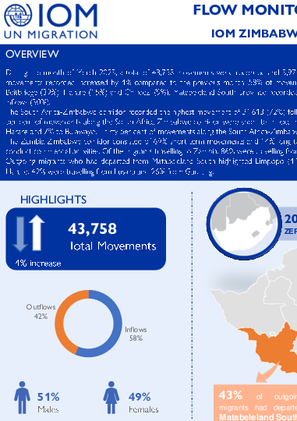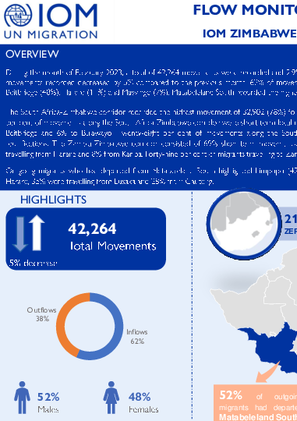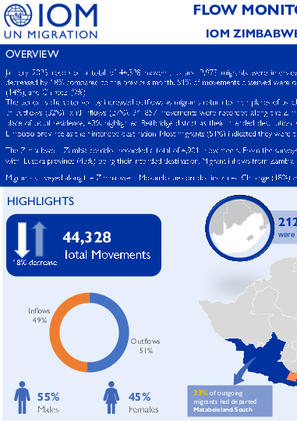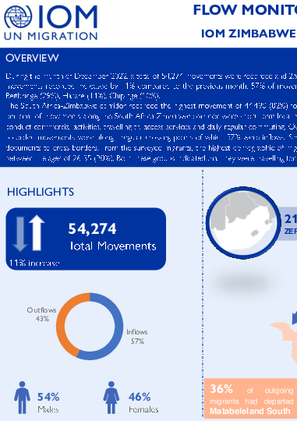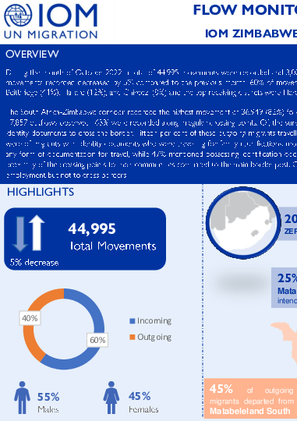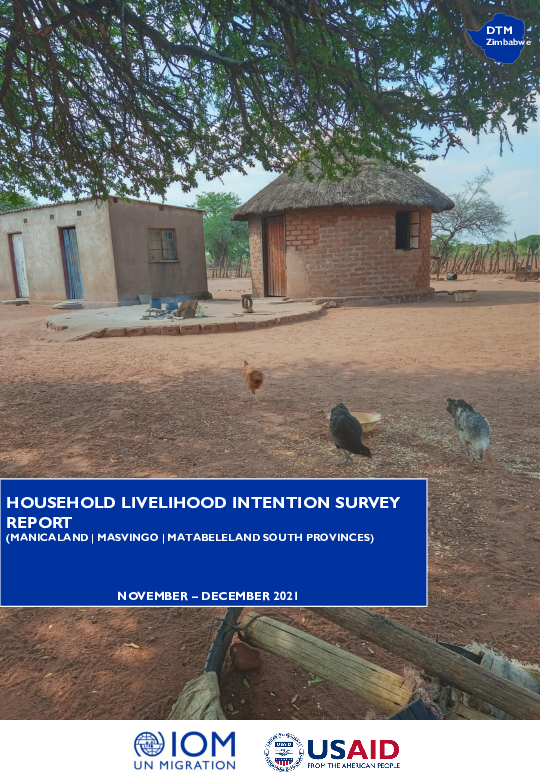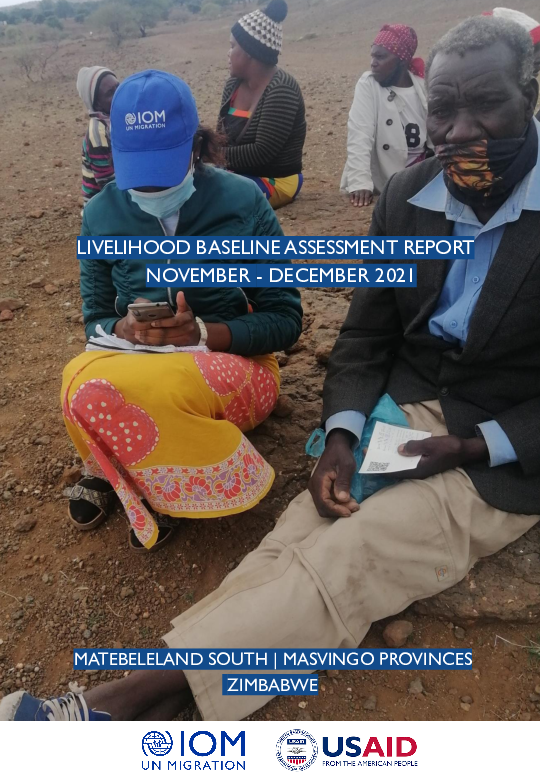-
Countries
-
Data and Analysis
-
Special Focus
-
Crisis Responses
Zimbabwe
Zimbabwe
Desplazados internos rastreados
Movimientos de desplazamiento
No hay cifras disponibles
IDMC 2023
Ronda de recopilación de datos
Sobre Zimbabwe
Zimbabwe is prone to rapid and slow onset disasters of both natural and man-made origins that have repeatedly caused several devastating effects and triggered population displacement. Over the last decade, natural disasters caused by cyclones and El-Nino, as well as socioeconomic and political factors have all contributed to migratory movements in the country. In some areas, this has jeopardized hard-won developmental gains particularly in the Southern and Eastern regions, which cover the Matabeleland North, Matabeleland South, Masvingo and Manicaland provinces of Zimbabwe. The International Organization for Migration (IOM) has been implementing a collaborative initiative that is primarily aimed at monitoring and advocating for the rights of vulnerable and at-risk populations, which include, but are not limited to, internally displaced persons (IDPs), host communities, women, girls, men and boys.
DTM in Zimbabwe collects key information on internally displaced persons (IDPs) and returnees through different components and methodologies throughout the country. Information collected include the location, numbers, periods of displacement, area of origin, needs and vulnerabilities of the population displaced as well as services available and return intentions In order to monitor and track population mobility due to displacements, IOM launched the Displacement Tracking Matrix (DTM) to support the Government of Zimbabwe and partnering humanitarian agencies to provide on time assistance to the population affected by the displacement through evidence-based planning and programming.
Current Donors
- Sweden
DTM Support
DTMsupport@iom.int
Para obtener resultados de búsqueda más avanzados, vaya a la Página de búsqueda avanzada de informes
Zimbabwe — Flow Monitoring Report (June 2024)
During the reporting period a total of 49,751 movements were recorded and 1,982 migrants were interviewed across 20 Flow Monitoring Points (FMPs) in Zimbabwe. The total movements recorded decreased by 14 per cent compared to the previous month.
Jul 22 2024
Zimbabwe — Flow Monitoring Report (June 2024)
May 30 2024
Zimbabwe — Flow Monitoring Report (April 2024)
Zimbabwe — Flow Monitoring Report (March 2024)
During the reporting period a total of 58,276 movements were recorded and 2,103 migrants were interviewed across 20 Flow Monitoring Points (FMPs) in Zimbabwe. The total movements recorded increased by 6% compared to the previous month.
Apr 29 2024
Zimbabwe — Flow Monitoring Report (March 2024)
Zimbabwe — Flow Monitoring Report (February 2024)
During the reporting period a total of 54,960 movements were recorded and 3,379 migrants were interviewed across 38 Flow Monitoring Points (FMPs) in Zimbabwe. The total movements recorded decreased by 12% compared to the previous month.
Zimbabwe — Flow Monitoring Report (January 2024)
During the reporting period a total of 62,339 movements were recorded and 3,811 migrants were interviewed across 38 Flow Monitoring Points (FMPs) in Zimbabwe. The total movements recorded decreased by 43% compared to the previous month.
Apr 29 2024
Zimbabwe — Flow Monitoring Report (January 2024)
Zimbabwe — Flow Monitoring Report (November 2023)
During the month of November 2023, a total of 58,669 movements were recorded and 3,679 migrants were interviewed across 38 Flow Monitoring Points (FMPs) in Zimbabwe. The total movements recorded increased by 0.2% compared to the previous month.
Zimbabwe — Flow Monitoring Report (August 2023)
During the month of August 2023, a total of 52,184 movements were recorded and 3,363 migrants were interviewed across 37 Flow Monitoring Points (FMPs) in Zimbabwe. The total movements recorded increased by 15% compared to the previous month.
Dec 11 2023
Zimbabwe — Flow Monitoring Report (August 2023)
Zimbabwe — Flow Monitoring Report (September 2023)
During the month of September 2023, a total of 49,211 movements were recorded and 3,315 migrants were interviewed across 38 Flow Monitoring Points (FMPs) in Zimbabwe. The total movements recorded decreased by 6% compared to the previous month.
Zimbabwe — Flow Monitoring Report (October 2023)
During the month of October 2023, a total of 58,550 movements were recorded and 3,415 migrants were interviewed across 38 Flow Monitoring Points (FMPs) in Zimbabwe. The total movements recorded increased by 19% compared to the previous month.
Dec 11 2023
Zimbabwe — Flow Monitoring Report (October 2023)
Zimbabwe — Flow Monitoring Report (July 2023)
During the month of
Aug 30 2023
Zimbabwe — Flow Monitoring Report (July 2023)
Zimbabwe — Flow Monitoring Report (June 2023)
During the month of
Aug 30 2023
Zimbabwe — Flow Monitoring Report (June 2023)
Zimbabwe — Flow Monitoring Report (May 2023)
During the month of May 2023, a total of 48
Aug 30 2023
Zimbabwe — Flow Monitoring Report (May 2023)
Zimbabwe — Flow Monitoring Report (April 2023)
During the month of April 2023, a total of 40,674 movements were recorded and 2,545 migrants were interviewed across 34 Flow Monitoring Points (FMPs) in Zimbabwe.
Aug 30 2023
Zimbabwe — Flow Monitoring Report (April 2023)
Zimbabwe — Flow Monitoring Report (March 2023)
During the month of March 2023, a total of 43,758 movements were recorded and 3,972 migrants were interviewed across 34 Flow Monitoring Points (FMPs) in Zimbabwe. The total movements recorded increased by 4% compared to the previous month.
Apr 28 2023
Zimbabwe — Flow Monitoring Report (March 2023)
Zimbabwe — Flow Monitoring Report (February 2023)
During the month of February 2023, a total of 42,264 movements were recorded and 2,957 migrants were interviewed across 34 Flow Monitoring Points (FMPs) in Zimbabwe. The total movements recorded decreased by 5% compared to the previous month.
Zimbabwe — Flow Monitoring Report (January 2023)
January 2023 recorded a total of 44,328 movements and 2,973 migrants were interviewed across 33 Flow Monitoring Points (FMPs) in Zimbabwe. The total movements recorded decreased by 18% compared to the previous month. 51% of movements observed were outflows, whilst 49% were inflows.
Apr 28 2023
Zimbabwe — Flow Monitoring Report (January 2023)
Zimbabwe — Flow Monitoring Report (December 2022)
During the month of December 2022, a total of 54,274 movements were recorded and 2,922 migrants were interviewed across 33 Flow Monitoring Points (FMPs) in Zimbabwe. The total movements recorded increased by 11% compared to the previous month.
Zimbabwe — Flow Monitoring Report (November 2022)
During the month of November 2022, a total of 48,755 movements were recorded and 3,245 migrants were interviewed across 33 Flow Monitoring Points (FMPs) in Zimbabwe. The total movements recorded increased by 8% compared to the previous month.
Zimbabwe — Flow Monitoring Report (October 2022)
During the month of October 2022, a total of 44,995 movements were recorded and 3,089 migrants were interviewed across 43 Flow Monitoring Points (FMPs) in Zimbabwe. The total movements recorded decreased by 5% compared to the previous month.
Dec 20 2022
Zimbabwe — Flow Monitoring Report (October 2022)
Zimbabwe — Flow Monitoring Report (September 2022)
During the month of September 2022, a total of 47,210 movements were recorded and 3,251 migrants were interviewed across 43 Flow Monitoring Points (FMPs) in Zimbabwe. The total movements recorded increased by 11% compared to the previous month.
Zimbabwe — Flow Monitoring Report (August 2022)
During the month of August 2022, a total of 42,489 movements were recorded. 3,057 migrants were interviewed across 44 Flow Monitoring Points (FMPs) in Zimbabwe. The total movements recorded decreased by 4% compared to the previous month, in which 44,380 were observed.
Nov 03 2022
Zimbabwe — Flow Monitoring Report (August 2022)
Multisectoral Assistance and Livelihood support - Site Profiles in Matabeleland South and Masvingo (November - December 2021)
Electronic questionnaires were used to collect the data and purposive sampling was used for sample selection. Analysis of the data has been done using descriptive statistics and visualization techniques.
Multisectoral Assistance and Livelihood support in Manicaland, Masvingo and Matabeleland South (November - December 2021)
IOM, in partnership and close coordination with the Government of Zimbabwe, conducted DTM household intention assessments in villages assessed during the multisectoral village assessments in Chimanimani and Chipinge districts of Manicaland province in Zimbabwe.
Multisectoral Assistance and Livelihood support (November 2021)
Through the inception meeting done at district level with stakeholders from the Ministry of Local Government, Housing and Public works, Ministry of Public Service and Social welfare, Ministry of Lands, Agriculture, Fisheries, Water and Rural Resettlement, Ministry of Women Affairs, Community, Sma
Pagination
Para obtener resultados de búsqueda más avanzados, vaya a la Página de búsqueda avanzada de conjuntos de datos
Zimbabwe — Baseline Livelihood Assessment - Matabeleland South and Masvingo Provinces (December 2021)
2021-12-01
A baseline assessment is a sub-component of mobility tracking. It aims to collect data on IDP, migrant or returnee population presence in a defined administrative area of the country.
Zimbabwe — Tropical Cyclone Idai - Baseline Assessment — Round 7
2021-05-13
A baseline assessment is a sub-component of mobility tracking. It aims to collect data on IDP, migrant or returnee population presence in a defined administrative area of the country.
Zimbabwe — Tropical Cyclone Idai - Baseline Assessment — Round 6
2021-03-05
A baseline assessment is a sub-component of mobility tracking. It aims to collect data on IDP, migrant or returnee population presence in a defined administrative area of the country.
Zimbabwe — Tropical Cyclone Idai - Baseline Assessment — Round 5
2020-11-10
A baseline assessment is a sub-component of mobility tracking. It aims to collect data on IDP, migrant or returnee population presence in a defined administrative area of the country.
Zimbabwe — Tropical Cyclone Idai - Baseline Assessment — Round 4
2020-07-13
A baseline assessment is a sub-component of mobility tracking. It aims to collect data on IDP, migrant or returnee population presence in a defined administrative area of the country.
Zimbabwe — Tropical Cyclone Idai - Baseline Assessment — Round 3
2019-12-16
A baseline assessment is a sub-component of mobility tracking. It aims to collect data on IDP, migrant or returnee population presence in a defined administrative area of the country.
Zimbabwe — Tropical Cyclone Idai - Baseline Assessment — Round 2
2019-05-14
A baseline assessment is a sub-component of mobility tracking. It aims to collect data on IDP, migrant or returnee population presence in a defined administrative area of the country.
Zimbabwe — Tropical Cyclone Idai - Baseline Assessment — Round 1
2019-04-27
A baseline assessment is a sub-component of mobility tracking. It aims to collect data on IDP, migrant or returnee population presence in a defined administrative area of the country.



